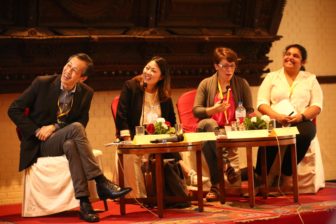
Uncovering Asia 2016 panel Muckrakers and Coders: Building a New Investigative Team – Reg Chua, Irene Liu, Mar Cabra and Kavya Sukumar
Newsrooms teams that traditionally included editors, reporters, designers, and photographers are increasingly transforming to make room for data experts.
At the Uncovering Asia 2016 conference in Nepal, Thomson Reuters data news editor Irene Liu, ICIJ Data and Research Unit head Mar Cabra, and Vox Media storytelling tools engineer Kavya Sukumar shared advice on managing and motivating data-minded investigative teams while staying focused on the ultimate goal: better journalism.
Establish Need for Data Team: During the Secrecy for Sale project, ICIJ relied on contracted developers to do the technical work, but non-staffers can lack availability and shared vision. “One of the lessons we learned from Secrecy for Sale is that data is an important component. We need a team on staff to be able to deal with this, or we won’t be able to do good investigative journalism,” Cabra said. In addition, staffer data reporters can continuously scrape websites, analyze data trends and provide insight on where to look for stories.
Whom to Hire First: Tap a journalist in your newsroom who already uses Excel and knows how to analyze data. An insider already knows how your newsroom functions, help them develop data skills. Otherwise consider the organization’s needs: do you need interactive graphics or a database? Who are you catering to?
Clear Goals: When working with designers and developers, be clear on what editorial wants and when. What do you need the platform to be able to do? “Discuss what makes sense. Keep track of progress,” Liu said.
The Right Vendor: If the newsroom does not have an in-house data team, choosing the right vendor with experience and a track record for good communication is important. For its Connected China project, Thomson Reuters engaged a vendor with developers, designers and writers to develop the front end of the app. Their structure was similar to a newsroom, so it was easy to convey what Reuters wanted.
Project Management: A proper project management tool, such as Basecamp, can make tracking information easier. Designate a person in charge of managing the data project, especially if the team is working on several stories concurrently.
Start Early: News editors should bring data reporters in at the beginning of the story so that they can start identifying what needs to be developed for the project.
Retain Your Talent: Make sure your data journalists feel like their contributions matter and they are not overloaded. “This skill set is expensive. If you have the budget, spend it to retain the talent,” Sukumar said.
Controlling Access: Those considering a crowd-sourced database need to weigh the pros and cons of not being able to control the data. You risk data quality, so ensure you can do due diligence.
Tips for Data Journalists/Developers/Students:
- Before learning a (coding) language, become an Excel super-user. “I know it’s not sexy but you’ll get a lot out of it.” – Liu
- If you are interested in data, make yourself that person in the newsroom who has data skills, who can do more than the typical investigative journalist. Develop your skills in your free time. – Cabra
- Reach out to other data enthusiasts in your community and build on that. – Cabra
- When discussing data projects with editors, they do not need to know the minute coding details but the end result. Don’t talk about it, show them. – Sukumar
- Regularly brainstorm with the editorial team. – Cabra
- Find data-related internships at organizations with people who can mentor and teach you how to do things more efficiently. – Sukumar
- Picking a coding language is a challenge. You may be tempted to pad on languages on your resume but the end goal of what you want to achieve (and being able to get there) is more important. – Sukumar
- Look at projects being done by the best data journalists, see what you like most and find out what skills/languages they used. -Liu
- Journalists who have trouble convincing their editors of the importance of a data team, you won’t win them over by pitching an 18-month project involving reporters around the world. Work on successful day-to-day data projects that build their confidence. – Liu
- Many editors care about clicks, so speak their language. When your interactives or maps attract clicks and page views, you get the attention of the editor. – Cabra
Resources
- Lynda is an online learning platform with coding tutorials.
- Investigative Reporters and Editors (IRE) has a database of tipsheets. Membership is $70 and includes free access to premium versions of Tableau Desktop, a data analysis and visualization tool; Cometdocs, an online file conversion and storage tool to help journalists with PDF files, and Carto, an open source tool that allows storage and visualization of geospatial data on the web. Members also get a discount on SmartProcure.
- Autotune, is an open source system developed by Vox Media to help reporters create charts, graphs, quizzes and more.
- Blacklight is an open-source platform useful for searching for files.
- Linkurious helps search and visualize graph data through a simple web-based interface.
 Eunice Au is GIJN’s program assistant. She was previously a journalist in Malaysia for eight years and has written on a range of topics, including politics, crime, environment, terrorism, and entertainment. From 2011 to 2015, she worked for the New Straits Times. Her last position before joining GIJN was as Malaysia correspondent for Singapore’s The Straits Times.
Eunice Au is GIJN’s program assistant. She was previously a journalist in Malaysia for eight years and has written on a range of topics, including politics, crime, environment, terrorism, and entertainment. From 2011 to 2015, she worked for the New Straits Times. Her last position before joining GIJN was as Malaysia correspondent for Singapore’s The Straits Times.
